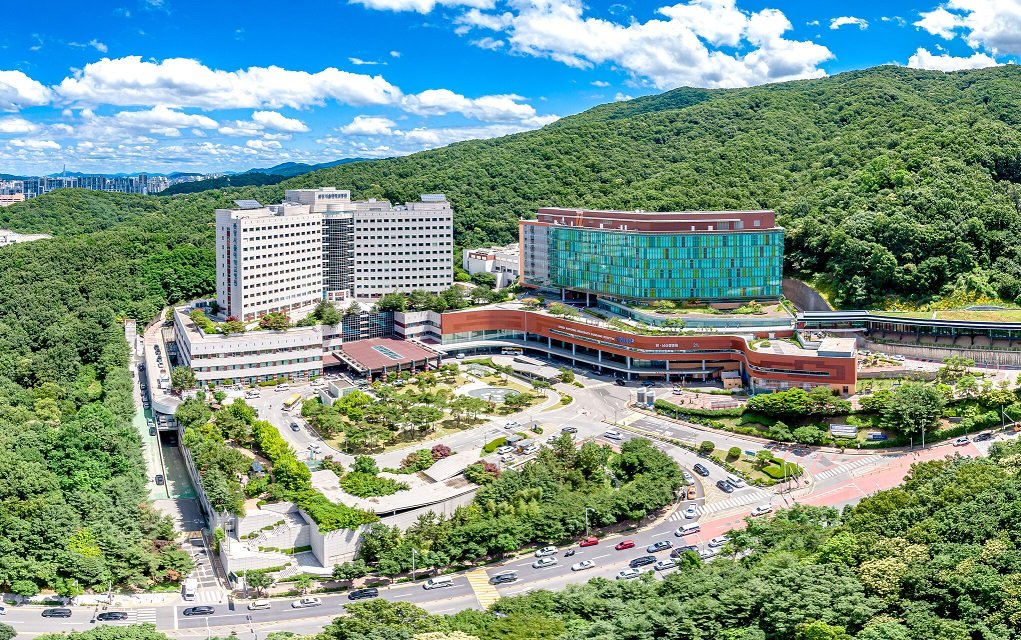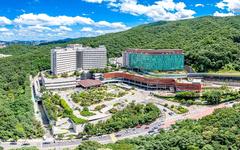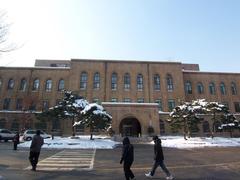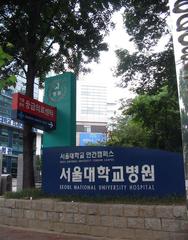
Seoul National University Hospital Visiting Hours, Tickets, and Guide
Date: 14/06/2025
Introduction to Seoul National University Hospital
Seoul National University Hospital (SNUH) stands as a symbol of South Korea’s medical progress and cultural heritage. Established in 1885 as Jejungwon, Korea’s first modern hospital, SNUH has played a pivotal role in shaping the nation’s healthcare landscape. Its central location in Seoul’s Jongno-gu district makes it accessible to visitors eager to explore both its storied past and its state-of-the-art medical facilities. Whether you are a healthcare professional, history lover, or traveler interested in Seoul’s cultural landmarks, this guide delivers essential details on visiting hours, tours, accessibility, and nearby attractions. For up-to-date visitor information, consult the SNUH Official Website and the Seoul Tourism Official Site.
Table of Contents
- Introduction
- Historical Overview: From Jejungwon to SNUH
- Visiting Hours and Admission
- Tours and Events
- Accessibility
- Nearby Attractions
- Travel Tips
- Visuals and Media
- FAQ
- Additional Resources
- Conclusion
Historical Overview: From Jejungwon to Modern Medical Excellence
Founded as Jejungwon in 1885, SNUH was the first institution to bring Western medicine to Korea. It has since evolved through pivotal moments such as the Japanese colonial era, post-liberation restoration, and modernization initiatives like the Minnesota Project. Today, SNUH is recognized for pioneering surgeries, groundbreaking research, and its contributions to public health and medical education.
Visiting Hours and Admission
- Visiting Hours: Monday to Friday, 9:00 AM – 5:00 PM. Limited weekend access may be available with prior arrangement.
- Admission: Free entry to public areas, including historical exhibits and outpatient clinics. Access to specialized departments and research facilities typically requires advance booking and permission.
Tours and Special Events
Guided tours are available, offering insights into SNUH’s historical milestones and medical achievements, such as Korea’s first open-heart surgery and advancements in liver disease research. Special events and exhibitions are hosted periodically, especially during hospital anniversaries or public health campaigns. For schedules, visit the official SNUH website or contact the visitor center.
Accessibility
SNUH is fully accessible, with ramps, elevators, and support services for visitors with disabilities. Signage is in both Korean and English. Staff at information desks are equipped to assist international guests. The hospital is conveniently reached via Seoul’s subway and bus networks.
Nearby Attractions
SNUH’s location in Jongno-gu puts it near several of Seoul’s most famous sites:
- Gyeongbokgung Palace: A historic royal complex accessible by subway.
- Insadong: A lively district known for traditional art, crafts, and tea houses.
- Bukchon Hanok Village: A charming area featuring traditional Korean homes.
These attractions can be easily combined with your visit to SNUH for a culturally enriching experience.
Travel Tips
- Photography: Allowed in public spaces but restricted in clinical and research areas for privacy reasons.
- Visitor Services: Cafés, rest areas, and free Wi-Fi are available.
- Language: English-language tours and brochures are offered; advance booking is recommended for guided experiences.
Visuals and Media
Virtual tours and photo galleries are available on the SNUH website, providing a comprehensive look at the hospital’s historic and modern architecture. All images include descriptive alt text for enhanced accessibility.
Frequently Asked Questions (FAQ)
Q1: Is there an admission fee to visit Seoul National University Hospital?
A1: No, public areas are free to access.
Q2: Can I take a guided tour?
A2: Yes, but tours require advance booking.
Q3: What are the visiting hours?
A3: Monday to Friday, 9:00 AM to 5:00 PM.
Q4: Is SNUH accessible for visitors with disabilities?
A4: Yes, the hospital is fully accessible.
Q5: What attractions are nearby?
A5: Gyeongbokgung Palace, Insadong, and Bukchon Hanok Village.
Additional Resources and Links
- Official Seoul National University Hospital Website
- Seoul Tourism Official Site
- Seoul National University Bundang Hospital
Conclusion
Seoul National University Hospital is a landmark of Korea’s medical innovation and cultural legacy. Its blend of historical significance and modern excellence offers a unique experience for visitors. Whether you’re interested in history, healthcare, or nearby cultural attractions, SNUH is a must-see stop in Seoul.
Plan your visit and explore the intersection of history, medicine, and culture at SNUH. For updates and events, follow SNUH on social media and consider using the Audiala app for guided experiences.
Gyeongbokgung Palace: A Majestic Monument of Seoul’s History and Culture
Introduction
Gyeongbokgung Palace, Seoul’s most iconic royal palace, is a monumental symbol of the Joseon Dynasty’s grandeur. Built in 1395, it has served as the principal royal residence and government seat, enduring wars and periods of restoration. Today, it remains one of the city’s premier historical attractions.
History and Significance
Gyeongbokgung means “Palace Greatly Blessed by Heaven.” Despite suffering destruction during Japanese invasions and occupation, the palace has been restored to showcase the splendor of Joseon architecture and royal life. Key buildings include Geunjeongjeon (Throne Hall), Gyeonghoeru Pavilion, and Hyangwonjeong Pavilion.
Visiting Information
- Opening Hours:
- March–October: 9:00 AM – 6:00 PM (last admission 5:00 PM)
- November–February: 9:00 AM – 5:00 PM (last admission 4:00 PM)
- Closed on Tuesdays
- Admission Fees:
- Adults: 3,000 KRW
- Youth (7–18): 1,500 KRW
- Children under 6: Free
- Location: 161 Sajik-ro, Jongno-gu, Seoul
- Getting There:
- Subway: Gyeongbokgung Station (Line 3), Exit 5
- Bus: Multiple routes nearby
Guided Tours and Special Events
Daily English-language tours provide insights into the palace’s history and architecture. Cultural performances, such as the royal guard changing ceremony and seasonal night-time festivals, enrich the visitor experience.
Accessibility
Gyeongbokgung is wheelchair-friendly, with ramps, elevators, and accessible facilities. Visitor centers offer assistance as needed.
Nearby Attractions
- National Folk Museum of Korea (inside palace grounds)
- Bukchon Hanok Village
- Insadong Cultural District
Frequently Asked Questions (FAQ)
Q: Can I take photographs inside the palace?
A: Yes, except in restricted areas.
Q: Are pets allowed?
A: No, pets are not permitted.
Q: Is there a dress code?
A: No, but respectful attire is suggested.
Q: Can I rent hanbok nearby?
A: Yes, and wearing hanbok grants free palace entry.
Maps and Visuals
Detailed maps are available at the entrance and online. Virtual tours and photo galleries enhance pre-visit planning.
Official Links and Resources
Conclusion
Gyeongbokgung Palace is an essential site for understanding Korea’s royal history and architectural artistry. Plan your visit, use travel apps for exclusive guides, and share your experience using #GyeongbokgungPalace.
Seoul National University Hospital Monument: Visiting Guide
Introduction
The Seoul National University Hospital (SNUH) Monument is a prominent cultural site in Jongno-gu, celebrating the legacy of SNUH’s contributions to Korean medicine.
History and Significance
Erected in conjunction with the Seoul National University College of Medicine, the monument highlights decades of medical innovation and education, blending traditional and modern design.
Visiting Hours and Tickets
- Opening Hours: Daily, 9:00 AM – 6:00 PM
- Tickets: Free admission
- Guided Tours: Weekends and public holidays at 11:00 AM and 3:00 PM (advance booking recommended)
Location and Accessibility
- Address: 101 Daehak-ro (Yeongeon-dong), Jongno-gu, Seoul 03080
- Subway: Hyehwa Station (Line 4), Exit 3; Anguk Station (Line 3), Exit 6 (with bus connection)
- Bus: Stops at Hyehwa and Changgyeong Palace Entrance
- Airport: Limousine Bus 6011 to Changgyeong Palace Entrance
The monument is wheelchair accessible and features multilingual signage.
Travel Tips
- Best Seasons: Visit in spring or autumn for optimal weather.
- Photography: Permitted; early morning or late afternoon offers the best light.
- Combine with: Changgyeong Palace, Marronnier Park, and the Daehak-ro theater district.
Special Events and Exhibitions
Cultural events, temporary exhibitions, and educational programs are frequently hosted. Check the official website for the current schedule.
FAQ
Q: Is photography allowed?
A: Yes, except where restricted.
Q: Are pets allowed?
A: No.
Q: Is parking available?
A: Yes, near Yeongeon Campus.
Q: Can I tour the hospital facilities?
A: No, only the monument and public areas are open to visitors.
Visuals and Media
Virtual tours and high-quality images can be accessed on the SNUH website and Seoul Tourism Official Site.
Useful Links
- Official Seoul National University Hospital Website
- SNU Yeongeon Campus Guide
- Seoul Tourism Official Site
Call to Action
Visit the SNUH Monument to experience a unique intersection of history, culture, and medical progress. For event updates, follow official channels and use travel apps for guided tours and insider tips.
Deoksugung Palace: Hours, Tickets, and Travel Guide
Introduction
Deoksugung Palace, centrally located near Seoul City Hall, is celebrated for its harmonious blend of Korean tradition and Western influences. As one of the Five Grand Palaces of the Joseon Dynasty, it offers a window into both royal history and architectural evolution.
History and Significance
Originally a secondary royal residence, Deoksugung became the main palace during the late Joseon period. Notable for its preservation through the Japanese occupation, its grounds feature traditional pavilions, Seokjojeon Hall, and the Jeonggwanheon tea house.
Visiting Hours and Tickets
- Opening Hours: Daily, 9:00 AM – 9:00 PM (last admission 8:00 PM), closed Mondays
- Ticket Prices:
- Adults: 1,000 KRW
- Youth (7–18): 500 KRW
- Children under 7: Free
Tickets can be purchased onsite or online via the Seoul Palaces website. Group and combination tickets are available.
Getting There
- Subway: City Hall Station (Line 1 or 2), Exit 2 (5-minute walk)
- Bus: Multiple routes
- Taxi: 서울특별시 중구 세종대로 99 (Sejong-daero 99, Jung-gu, Seoul)
Highlights
- Royal Guard Changing Ceremony: Daily at 2:00 PM and 3:30 PM
- Seokjojeon Hall: A neoclassical building now used for exhibitions
- Jeonggwanheon: Tea house in a tranquil garden
- Stone Wall Road: Scenic walkway along the palace wall
Nearby Attractions
- Seoul City Hall
- Cheonggyecheon Stream
- Myeongdong Shopping District
Visitor Tips
- Best Seasons: Spring and autumn
- Photography: Allowed in most outdoor areas; drones prohibited
- Accessibility: Wheelchair access and accessible restrooms available
- Language: English signage and staff assistance provided
FAQ
Q: Are guided tours available?
A: Yes, free English tours on weekends and holidays; audio guides for rent.
Q: Can I buy tickets online?
A: Yes, via the Seoul Palaces website.
Q: Is photography allowed inside the buildings?
A: In most outdoor areas, yes; restrictions apply indoors.
Q: Are pets allowed?
A: No.
Visuals and Media
Online photo galleries, virtual tours, and videos are accessible via the official Seoul palaces website.
Call to Action
Plan your visit to Deoksugung Palace now! For the latest information, check the official Seoul Palaces website and follow their social media for news, contests, and cultural programs.
Summary: Visiting Seoul National University Hospital
Seoul National University Hospital embodies Korea’s journey of medical innovation and cultural transformation. From its beginnings as Jejungwon to its present-day excellence, SNUH invites visitors to explore its rich legacy. The hospital and its adjacent monument are accessible, welcoming, and educational, and are conveniently located near Seoul’s top attractions. For the best experience, utilize guided tours, attend special events, and make use of visitor services. Stay updated and plan your trip through official resources (SNUH Monument Guide, Seoul Tourism Official Site), and consider travel apps for enhanced exploration.
References and Further Reading
- Seoul National University Hospital: A Historical Landmark and Visitor’s Guide, 2025 (https://www.snuh.org/english)
- Seoul National University Hospital Monument Visitor Guide, 2025 (https://www.snuh.org/global/en/about/EN05006001.do)
- Seoul Tourism Official Site, 2025 (https://english.visitseoul.net)















































































































































































































